Steemit Crypto Academy Contest / S18W3: Psychology and Market Cycle
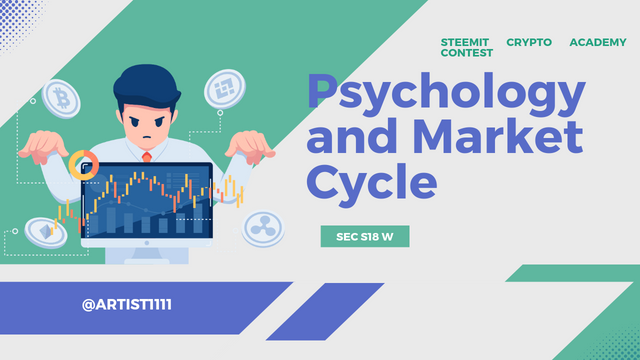
Hello everyone! I hope you are all doing well and enjoying life with the blessings of Allah Almighty. I am happy to take part in the exciting challenge hosted by SteemitCryptoAcademy community . So, without any further delay, let's dive right in! Shall we ? ........, Okay , Okay😊! .
Describe the psychological progression of investors through the stages of optimism, excitement, euphoria, anxiety, denial, fear, despair and hope. How does each step influence investor behavior? |
|---|
Understanding your feelings can help you stay on course whenever investing, which can feel like a psychological roller coaster. Optimism is the first step. Investors anticipate strong returns and are optimistic about fresh chances. When markets rise and investments do well, this confidence creates exhilaration. People begin to make investments more and speak about their successes as they become more self-assured.
Then euphoria sets in, marking the height of happiness and self-confidence when everyone thinks the market will continue to rise. Some people take mistakes in this phase because they believe they can't lose.
However, markets are capricious. When prices start to move, anxiety sets in. Investors fear that their improvements may be lost. While some begin to doubt their decisions, they keep on doing the hope for a small setback.
.webp) Market Phases Market Phases |
|---|
Price reductions cause denial to set place. Investors stay on because they can't bear to accept a loss and persuade themselves it's only for a moment Because it can frequently result in greater losses, this stage is risky. When the market continues to decline, fear takes control.
In an attempt to reduce their losses, investors jump to sell. This large-scale sale could lead in even lower prices. At this stage, hopelessness may surface. When they see how much less the value of their investments are now worth, they get pessimistic.
Many of them pledge never to invest again after comprehending their mistakes. The cycle's low point is at this point.
The market subsequently levels off, and some investors begin to feel optimistic. They are reasonably hopeful about future returns and think prices will rise, so they start buying again. A steady rebound of the market can end up from this gradual return of confidence. It's important that you understand these feelings.
You can make better selections if you are aware of whether your motivations are fear or greed. It's critical to establish a plan in order to control their emotions. Making definite rules for investing helps stop rash choices.
Technical analysis knowledge enables you to make recommendations on facts rather than intuition. Stress-reduction methods like meditation and physical activity. might help you maintain mental clarity.
Using a chart showing a recent movement in the price of a cryptocurrency (without date/time), identify which emotional stage of the market cycle the chart likely represents. Justify your answer by discussing behavioral signs that investors might exhibit at this stage. |
|---|
I'm going to show how the recent movement in Bitcoin's price reflects various emotional stages in the market cycle. This helps explain why traders react the way they do at different points.
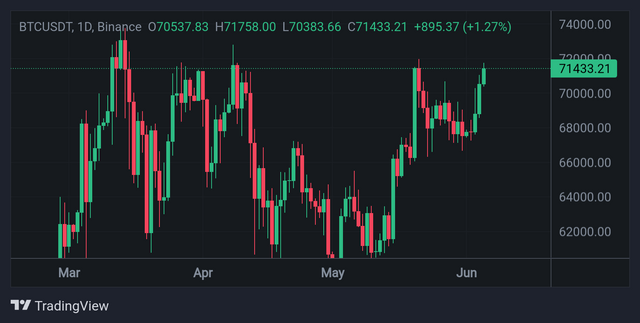 Blank Chart Blank Chart |
|---|
First, let's look at Bitcoin reaching $62,000. Traders are feeling optimistic, believing prices will continue to rise. As it hits $64,000, excitement kicks in, with traders feeling confident about their investments. They start buying more, expecting even higher returns. When the price reaches $66,000, euphoria sets in. Traders are on top of the world, convinced that the price will only go up. This is when risky decisions are often made.
Then, the price drops slightly to $65,000, causing anxiety. Traders begin to worry about their profits and whether they should sell. When it falls to $64,000, denial occurs. Many traders convince themselves that this is just a temporary dip and hold onto their investments, hoping for a rebound.
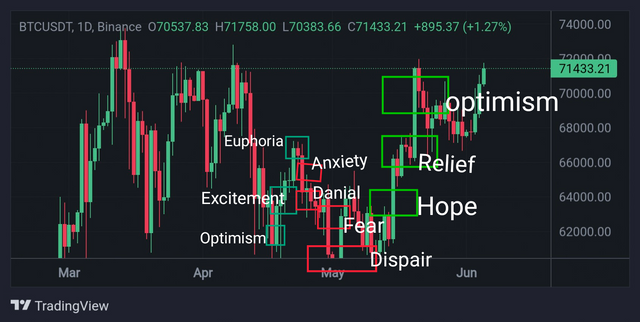 Various phases Various phases |
|---|
As the price continues to drop to $63,000, fear sets in. Traders start to panic, selling their holdings to avoid further losses. The price plunges to $61,500, and despair takes over. Traders feel hopeless, regretting their decisions and fearing they’ve lost everything.
But the market begins for bouncing back. Hope revives at $64,000 as investors think the worst is behind us. They slowly start making purchases again. They are relieved and believe they have survived the storm when the price rises to $66,000.
At last, Bitcoin reaches $71,423, reviving hope. Once more, investors have optimism and confidence for the future. Comprehending these affective phases elucidates the reasons behind market dynamics and underscores the need of emotional management in trading.
Traders can avoid the dangers of emotional investing and make better selections by identifying these trends.
Discuss how an incorrect mindset, such as the belief that "this time it's different," can affect an investor's decisions and potential returns. How does this mentality typically affect a person's performance in the market during volatile phases? |
|---|
Believing "This Time It's Different" and Its Impact on Investors
Believing that "this time it's different" can lead investors to make poor choices. This mindset makes people think the usual market rules don't apply. When they believe markets will keep going up, they might invest too much money. If the market crashes, they could lose a lot. During volatile times, this belief can cause investors to ignore warning signs, making bad situations worse.
Investors frequently become overconfident when they believe a certain thing is different. They begin to believe they are unbeatable. They may take more chances as a result of their overconfidence. They could purchase stocks, for instance, at a premium because they think the price will rise further. These investors may suffer large losses if the market declines.
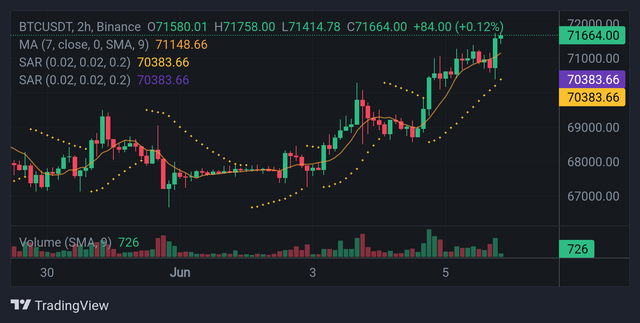
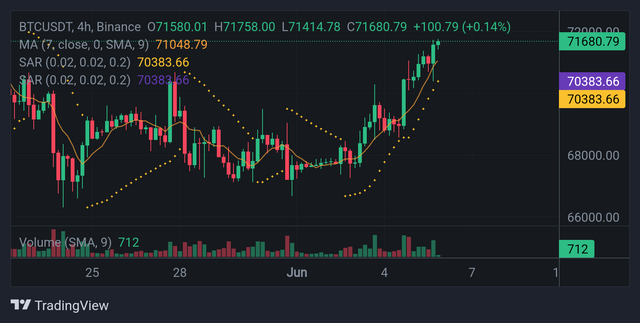
When they were inconsiderate, their market performance typically suffered. Additionally, this mindset leads investors to overinvest in the market. They believe that prices will always improve again, therefore they don't sell because they should. Their investments lose a lot of value when the market declines. They may regret their choices as the consequence of this denial and experience lower returns.
When people eventually discover the market isn't working, it can result in panic selling.It can lead to panic selling when they finally realize the market isn't recovering soon.
This kind of thinking strengthens distressing feelings like fear and greed. Greed drives people to purchase more while the market is rising. They sell at a loss when the market plummets because fear takes over. Their financial examine could be ruined by this emotional roller coaster.
Even at moments of intense emotion, it's critical to maintain a well-defined plan and to follow it. Recalling the unpredictable nature of markets is vital for traders to elude this trap. They shouldn't think that this time is different from previous cycles and instead learn from them.
They can safeguard their money by taking an measured approach and resisting the urge to follow the herd. Maintaining self-control and emotional regulation can result in improved performance over the long run.
Examine a specific incident where significant FOMO (fear of missing out) or FUD (fear, uncertainty, and doubt) impacted the price of the STEEM token. Discuss how this sentiment influenced trading behaviors and the price of the STEEM token. Also suggest strategies that STEEM investors could use to avoid making decisions driven by these emotions. |
|---|
Just last week, the price of STEEM token started rising rapidly, causing many investors to feel FOMO or fear of missing out.
When the price reached $0.31, some investors, like me, decided to sell because they were worried it was just a temporary spike. However, the price continued to climb to $0.335, making those who sold feel uncertain and doubtful about their decision.
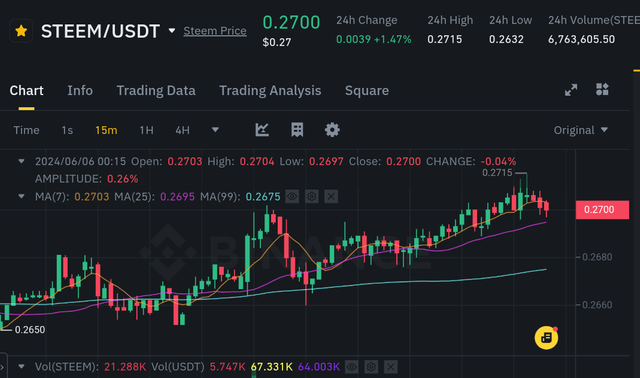 Binance Binance |
|---|
FOMO and FUD can heavily influence trading behaviors and the price of the STEEM token. When people fear missing out on potential gains, they might buy impulsively, driving prices up. Conversely, uncertainty and doubt can lead to panic selling, causing prices to drop suddenly.
STEEM investors can employ techniques like pre-establishing buy and sell points based according to their investing objectives to prevent making decisions that are influenced by these feelings.
STEEM investors have various tools at their disposal to help them avoid making judgments based on emotions such as FOMO or FUD.
First of all, establishing predefined buy and sell targets in accordance with individual investing objectives can offer a transparent framework for making decisions.
Furthermore, keeping up with project updates, market trends, and fundamental analysis can assist investors in making data-driven decisions rather than gut instincts.Investing in a diverse range of assets can help spread out risk & lessen the effect of market fluctuations on total returns.
Finally, even in uncertain times, investors may avoid rash decisions and ultimately make better-informed choices by exercising patience & discipline and adhering to a sound investment plan.
Explain the logic behind the “buy red and sell green” strategy. Create a hypothetical scenario in which this strategy could be applied effectively and discuss the psychological challenges an investor might face when trying to implement this strategy amid an actual market downturn and subsequent recovery. |
|---|
The "buy red and sell green" strategy involves buying assets when their prices drop (red) and selling them when prices rise (green). The logic behind this is to capitalize on market fluctuations, buying low and selling high to maximize profits.
Let's imagine a scenario where this strategy could work well:
Imagine that unexpectedly bad economic developments causes the stock market to plunge. Many stocks see their rates fall, including the shares of an information technology business you've had your eye on. Rather than being alarmed like others, you view this as a chance.
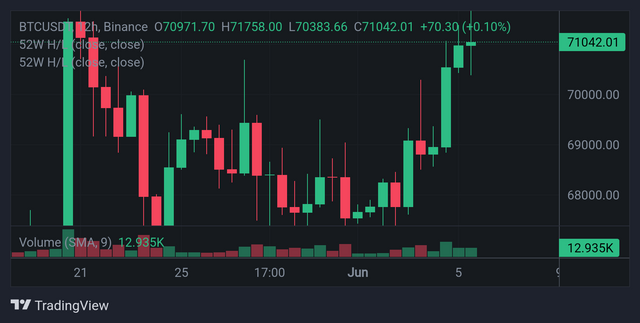 TradingView TradingView |
|---|
You choose to purchase tech business shares at a discount in the hopes of an anticipated rise in value. But putting this plan into practice is difficult, particularly when the market is down. The psychological obstacle arises from the uncertainty and worry associated with lower prices.
Fearing more losses, numerous stakeholders experience anxiety and may be reluctant to purchase. This anxiety may cause you that could be passed up chances to purchase inexpensive goods.
As the market starts to bounce again, there's another mental obstacle. As prices begin to rise, greed sets in (green). Investors who expect even greater returns may grow overconfident and hesitant to sell.
This resistance to selling may result in lost chances to lock in profits. The "buy red and sell green" approach requires investors to overcome these psychological obstacles in order to be used successfully.
In the face of market volatility, they must maintain their composure and reason, concentrating on long-term investing objectives rather than cyclical swings.
Conclusion |
|---|
kind Regards
@artist1111

Adieu, folks!
May the winds of fortune
carry you to greatness!
May the winds of fortune
carry you to greatness!
Very well written and comprehensive write up. It was very engaging and cohesive . Here are my reflections on few points;
Yeah, that's true. Investors start with a positive attitude, expecting good results. They feel hopeful about the market's potential and are eager to invest in new opportunities.
Absolutely true. When people are too confident, they make bad decisions, thinking the market will always go up. They might ignore risks and invest too much, believing they're invincible.
That's correct. When many people sell at the same time, it can make prices drop even more. The increased supply and lack of buyers push prices down further, worsening the market situation.
In my opinion, that's absolutely true. Thinking that market rules don't apply anymore can make people make bad decisions. They might ignore past lessons and common risks, leading to overconfidence and significant financial losses.
Thank you
Congratulations, your comment has been successfullycurated by our team via @𝐢𝐫𝐚𝐰𝐚𝐧𝐝𝐞𝐝𝐲 at 5%
Thanks my friend for your feedback,appreciated .
Upvoted. Thank You for sending some of your rewards to @null. It will make Steem stronger.
@artist1111 Its a great reminder of how important it is to understand our feelings and stay disciplined in our investment strategies. Recognizing these emotional stages can help us avoid impulsive decisions driven by fear or greed. Your analysis is spot on and very insightful. Good luck with the contest
Thanks my friend for your feedback,appreciated .
Your post has been successfully curated by our team via @𝐢𝐫𝐚𝐰𝐚𝐧𝐝𝐞𝐝𝐲 at 35%.
Thank you for your committed efforts, we urge you to do more and keep posting high-quality content for a chance to earn valuable upvotes from our team of curators and why not be selected for an additional upvote later this week in our top selection.
Very systematic discussion. Talking about emotions, I often experience it. Previously, I felt more panic than hope. But, after learning a lot about managing emotions, now I have more hope.
Thanks my friend for your feedback,appreciated .
It's like taking a rollercoaster ride through the minds of investors. Imagine feeling super pumped up, then getting a bit nervous, and maybe even hitting a point of total panic. Each of these emotions affects how investors make decisions, whether they're feeling all-in or ready to bail. So, it's key to keep those emotions in check to make smart moves in the investing world. Good luck brother
Thanks my friend for your feedback .
I love how old you broke down all the different psychological emotions in which traders experience from optimism to despair and I must say you're definitions are all top notch. Such high quality skill is very valuable to the platform and I appreciate your work hopefully I see more of such high quality content from you in no distance time
Thank you so much friend for sharing sword high quality article at your free time you can also check my through the link belowhttps://steemit.com/hive-108451/@starrchris/steemit-crypto-academy-contest-s18w3-psychology-and-market-cycle
Thanks, I'm glad you found the breakdown useful. Your support is motivating.
If the key to profit is simply ignored because of our emotions of wanting to get more, then that would be a shame, right?
The belief and anxiety phase is a phase that is enough to make the soul turbulent, here the decision to move forward and back should be taken without involving emotions.
For the most part, actions in trading are controlled by emotions, therefore control emotions first before entering into trading,
Good presentation friend, I learned a lot from you, good luck....
👍👍👍